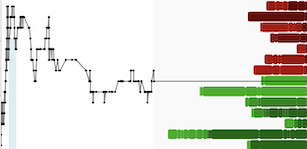Years from now, we may look back at Friday October 6th, 2023 as being a pivotal turning point for both financial markets and the U.S. economy. That morning, the September nonfarm payrolls report was released, showing a stunning increase of 336,000 nonfarm payrolls in the U.S., defying the consensus estimate of 170,000. Earlier this month, we learned that the Bureau of Labor Statistics revised both the August and September employment numbers lower by a total of 101,000. It is possible that the surprising September number will be revised lower once again when we get the November nonfarm employment report in two weeks.
The trend in the nonfarm employment data is clearly indicative of a weakening U.S. labor market:

On the morning of October 6th, gold initially traded lower to $1823.50 but quickly changed direction and began to reverse higher, closing the session at $1845.20:
Gold (Daily)

This trading session was particularly notable due to the fact that the vast majority of market participants would likely have chosen to sell gold in light of the stunning upside surprise in the U.S. employment numbers. However, that day proved to be the beginning of a marked change of character in the gold market - the ensuing rally saw gold trade from $1823 on the morning of October 6th to as high as $2,019 on the afternoon of October 27th (just three weeks later).
It appears that central bank gold buyers have been persistent in their accumulation of gold on dips. The early October V-reversal may have been the latest example of central bank dip buying in gold.

We have witnessed a sharp uptick in central bank gold buying beginning in mid-2022 (shortly after Russia's invasion of Ukraine and the West froze Russian assets)
In recent weeks, gold has traded in a well contained range between roughly $1940 and $2010:
Gold (Daily - One Year)

The early November correction found support at the upward sloping 50-day moving average near $1940, and gold traded back above $2,000 as recently as yesterday. As we get ready to enter the final month of 2023, gold is up roughly 9% year-to-date and trading a whisker below $2,000. While many market participants are mesmerized by the $2,000 round number psychological level, it is $2020 that is the next real overhead resistance level.
A breakout above $2020 in the next few weeks would be very promising indeed.
December has a tendency to be a strong month for gold. In fact, since 2017 gold has been up every December for an average monthly gain of 3.9%.

What I find most interesting about gold’s strong performance over the last year is that it has occurred against a backdrop of weak investor demand via ETFs and physical coin/bar sales:

Furthermore, gold has broken its historical correlation with real yields by rising during a period of time in which real yields experienced one of the sharpest rises in history:

US 10-year real rates have moved from -1% in early 2021 to positive 2.16% today. During that same time frame we have seen gold move up from $1862 to $1993. It is this sort of seismic shift in long held asset class correlations that indicates that global fund flows are shifting; the way it was between the year 2000 and 2020 is not the way it is today. Moreover, it is clear to anyone that is paying attention that the shift that is underway favors real assets such as gold.
The conventional wisdom has held that positive real rates are decidedly negative for gold. Gold has remained out of favor among institutional investors, as evidenced by declining AUM (assets under management) in gold ETFs, including the GLD (physical gold) and GDX (gold miners). If anything, gold's stubborn resilience throughout 2023 portends more favorable conditions ahead for the yellow metal.
Entering 2024, the biggest fundamental drivers of the gold price will surely be the timing of Fed policy rate cuts, and the resulting movements of the US dollar. Some analysts even believe that a Fed rate cut in March 2024 could trigger an outsized rally in the gold price, to $2400/oz.
While the short term gold price movements will largely be driven by the perceived health of the US economy, and the Fed Funds Rate. A much bigger shift is already underway in global fund flows. Global trade is gradually beginning to move away from the US dollar, with more and more transactions being settled in non-dollar currencies such as the Chinese yuan. Zoltan Pozsar explains it well beginning at the 20:40 mark in this video. As a result of the ongoing efforts by BRICS nation to diversify away from the US dollar, US Treasury issuance will be increasingly domestically underwritten, as opposed to globally underwritten (like it was from 2000 to 2020).

After running a $1.7 trillion budget deficit in 2023, the U.S. government budget deficit is expected to total $1.8 trillion in 2024
When this major shift in Treasury debt consumption is considered against a backdrop of burgeoning US government deficits, it creates an increasingly imbalanced dynamic. An imbalanced dynamic that will inevitably require the Federal Reserve to step in and subsidize the Treasury to the tune of trillions of dollars. A scenario that involves a diminishing role for the US dollar in global trade, in combination with Federal Reserve monetization of Treasury debt is an extremely bullish one for the timeless store of value called gold.
Given that 2024 is an important election year in the United States, we can expect a growing government deficit and a central bank doing whatever it can to try to orchestrate a soft landing for the US economy. Just like the gold dip buyers of October 6th were not fooled by the non-farm payrolls report, the gold buyers of December 2023 are not likely to be fooled by economist prognostications of a soft landing.
The charts are offering some subtle clues of what's to come.
Today’s setup in gold is reminiscent of summer 2019 when the yellow metal surged from $1275 to $1550 over the span of four months. The proximate cause of gold’s summer 2019 surge was the Fed’s pivot to cutting interest rates three times in 2019, after previously threatening to tighten further at the end of 2018. After repeatedly stating throughout 2023 that rate cuts were not on the table, a Fed pivot to cutting rates several times in 2024 would offer parallels to 2018/2019.
Gold (Monthly - 10 Year)

In addition, the chart setup has many similarities to 2019. Throughout 2016/2017/2018 gold ran into resistance near $1370 on numerous occasions, before eventually breaking through that resistance level with terrific force in June 2019. In the past 3 years, gold has found resistance near $2,080 on several occasions ($2,089 was the August 2020 high). One has to wonder if a 4th test of this resistance level would prove to be decisive, very much like gold’s breakout in June 2019.
DISCLAIMER: The work included in this article is based on current events, technical charts, company news releases, and the author’s opinions. It may contain errors, and you shouldn’t make any investment decision based solely on what you read here. This publication contains forward-looking statements, including but not limited to comments regarding predictions and projections. Forward-looking statements address future events and conditions and therefore involve inherent risks and uncertainties. Actual results may differ materially from those currently anticipated in such statements. This publication is provided for informational and entertainment purposes only and is not a recommendation to buy or sell any security. Always thoroughly do your own due diligence and talk to a licensed investment adviser prior to making any investment decisions. Junior resource companies can easily lose 100% of their value so read company profiles on www.SEDAR.com for important risk disclosures. It’s your money and your responsibility.





